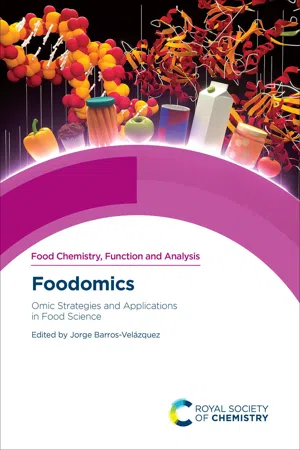![]()
Chapter 1
Foodomics – Fundamentals, State of the Art and Future Trends
G. Álvarez-Riveraa, A. Valdésa, C. León,b and A. Cifuentesa
a Laboratory of Foodomics, Institute of Food Science Research, CIAL, CSICNicolás Cabrera 928049 MadridSpain
[email protected] b Department of Bioengineering, Universidad Carlos III de Madrid, LeganésMadridSpain
Foodomics is being consolidated in food science through the application and integration of a variety of omics tools (e.g., genomics, transcriptomics, proteomics, metabolomics) together with chemometrics and bioinformatics. Foodomics can greatly improve our understanding of the complex food–diet–individual interplay, involving different food science and nutrition research areas dealing with food composition, food safety, quality and traceability issues, as well as the effects of food on an individual's health or illness status. Readers of this chapter will get an overview of the fundamentals, the most recent advances and future perspectives in the different areas of foodomics.
1.1 Introduction
Researchers in modern food science and nutrition are moving from classical methodologies – traditionally used e.g., to provide a descriptive view of raw food composition or to investigate functional and nutritional factors – to more advanced and multi-disciplinary strategies. These new approaches adopt well-established methodologies in medical, pharmacological, and/or biotechnological research, making use of advanced omics tools and bioinformatics, along with in-vitro, in-vivo and/or clinical assays.1 As a result of this trend, new interdisciplinary research areas such as nutrigenomics, nutrigenetics, nutritional genomics, nutritranscriptomics, nutriproteomics, nutrimetabolomics, microbiomics, toxicogenomics, and systems biology have emerged.
The new omics technologies have the potential to widen the scope of traditional targeted analysis and open up impressive possibilities to explore formerly unanswered questions and problems relevant to food science and nutrition. They have become powerful tools to tackle the comprehensive assessment of food safety, the first challenge for food researchers, that largely affects our health as consumers in a globalized market. Since many products contain multiple and processed ingredients, very often shipped from different parts of the world, worldwide movement of food and related raw materials have been repeatedly demonstrated to undergo global contamination episodes. Therefore, ensuring the safety, as well as the quality and traceability of food has never been more complicated and necessary than today.
In this line, European Food Safety Authority (EFSA) has opened a scientific debate on the integration of data produced by omics into the risk assessment of food, including the safety assessment of transgenic or genetically modified (GM) foods among others.2,3
Current trends in modern food science and nutrition are increasingly focused on understanding the food and health interplay. Food is now considered not only a source of energy but also an affordable way to prevent future diseases, as many food components are potential sources of health-promoting compounds. The possibility of employing food products tailored to promote the health and well-being of groups of populations identified on the basis of their individual genomes is an impressive opportunity opened by these new omics approaches. However, to scientifically demonstrate the health effect of food and food ingredients, analytical strategies have to face important difficulties derived, among others, from food complexity, the huge natural variability, the large number of different nutrients and bioactive food compounds, their very different concentrations, their bioavailability and transformation in the human digestive tract, the numerous targets with different affinities and specificities that might exist in the human body, etc. Thus, understanding the biochemical, molecular and cellular mechanisms that underlie the beneficial or adverse effects of certain bioactive food components is currently a hot topic in food research considered unapproachable few years ago.
In this context, there is an understandable need for innovative, high-throughput, multi-omics platforms able to provide the necessary data and information to offer real solutions and answers to the actual challenges in food science. Foodomics emerges as an integrative framework that involves not only gathering data coming from the different omics approaches but also the integration of all of them using advanced bioinformatics tools to be able to end up with the whole picture of the food–biological system interaction.4
In the following sections, the principles of foodomics including the fundamental omic tools employed, and its implications in food science and nutrition will be comprehensively described. Furthermore, an updated evaluation of representative foodomics applications in the field of foods safety, quality and traceability as well as in nutrition and health research will be provided. At the end of the chapter, the future challenges and foreseen trends that will face this promising discipline are discussed.
1.2 Principles and Fundamentals of Foodomics
Foodomics, as defined in 2009,5 is ‘a discipline that studies the food and nutrition domains through the application and integration of advanced omics technologies to improve consumer's well-being, health, and confidence’. Foodomics is, therefore, a broad discipline that integrates all the multidisciplinary approaches in modern food science and nutrition (e.g. nutrigenomics, nutrigenetics, microbiomics, toxicogenomics, nutritranscriptomics, nutriproteomics, nutrimetabolomics, etc.). Considering the complexity of the foodome, defined as ‘the collection of all compounds present in any investigated food sample and/or in any biological system interacting with the investigated food at a given time’,6 the implementation of omics platforms, such as transc...
